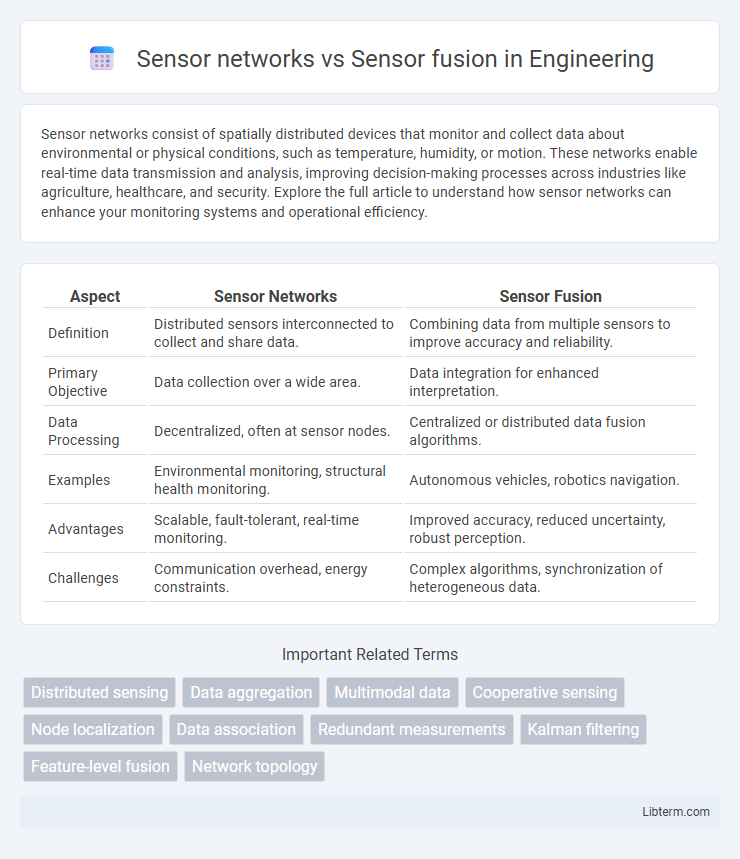Sensor networks consist of spatially distributed devices that monitor and collect data about environmental or physical conditions, such as temperature, humidity, or motion. These networks enable real-time data transmission and analysis, improving decision-making processes across industries like agriculture, healthcare, and security. Explore the full article to understand how sensor networks can enhance your monitoring systems and operational efficiency.
Table of Comparison
| Aspect | Sensor Networks | Sensor Fusion |
|---|---|---|
| Definition | Distributed sensors interconnected to collect and share data. | Combining data from multiple sensors to improve accuracy and reliability. |
| Primary Objective | Data collection over a wide area. | Data integration for enhanced interpretation. |
| Data Processing | Decentralized, often at sensor nodes. | Centralized or distributed data fusion algorithms. |
| Examples | Environmental monitoring, structural health monitoring. | Autonomous vehicles, robotics navigation. |
| Advantages | Scalable, fault-tolerant, real-time monitoring. | Improved accuracy, reduced uncertainty, robust perception. |
| Challenges | Communication overhead, energy constraints. | Complex algorithms, synchronization of heterogeneous data. |
Introduction to Sensor Networks and Sensor Fusion
Sensor networks consist of spatially distributed sensor nodes that cooperatively monitor physical or environmental conditions, enabling data collection over large areas with high reliability. Sensor fusion integrates data from multiple sensor types or nodes to improve the accuracy and robustness of information by combining diverse measurements into a unified context. Both technologies enhance real-time decision-making in applications such as environmental monitoring, healthcare, and industrial automation by leveraging sensor collaboration and data synthesis.
Core Principles of Sensor Networks
Sensor networks consist of spatially distributed sensors that collectively monitor physical or environmental conditions, emphasizing decentralized data collection and communication. Core principles include scalability, energy efficiency, fault tolerance, and collaborative data processing to ensure reliable information transmission. These networks rely on sensor nodes with limited computational power, requiring optimized protocols for data sensing, aggregation, and routing.
What is Sensor Fusion?
Sensor fusion is the process of integrating data from multiple sensor networks to produce more accurate, reliable, and comprehensive information than any individual sensor can provide alone. By combining inputs from diverse sensors like radar, lidar, cameras, and GPS, sensor fusion enhances situational awareness in applications such as autonomous vehicles, robotics, and environmental monitoring. This technique reduces uncertainty, improves detection accuracy, and enables robust decision-making in complex environments.
Key Differences Between Sensor Networks and Sensor Fusion
Sensor networks consist of spatially distributed sensors that collect and transmit data independently, emphasizing communication and data aggregation across multiple nodes. Sensor fusion integrates data from multiple sensors to produce more accurate, reliable, and comprehensive information by combining heterogeneous sensor inputs. The key difference lies in sensor networks managing and relaying sensor data across a network, whereas sensor fusion synthesizes data at the source or central processor to enhance decision-making.
Typical Applications of Sensor Networks
Sensor networks are widely employed in environmental monitoring, industrial automation, and smart agriculture, where distributed sensors collect and transmit data for real-time analysis and decision-making. These networks enable efficient tracking of parameters such as temperature, humidity, pollution levels, and equipment status across large areas or complex infrastructures. Compared to sensor fusion, which integrates data from multiple sensors to improve accuracy and reliability in applications like autonomous vehicles or robotics, sensor networks primarily emphasize spatial coverage and scalability.
Common Use Cases for Sensor Fusion
Sensor fusion integrates data from multiple sensors to enhance accuracy and reliability, commonly applied in autonomous vehicles for obstacle detection and navigation. It is also vital in wearable health devices, combining inputs like heart rate and motion to provide comprehensive health monitoring. Industrial automation extensively uses sensor fusion to optimize machine performance and predictive maintenance by correlating temperature, vibration, and pressure data.
Data Processing: Networks vs Fusion Techniques
Sensor networks rely on distributed data processing where individual sensor nodes collect and transmit raw data to centralized systems for analysis, often facing challenges like latency and bandwidth constraints. Sensor fusion techniques integrate data from multiple sensors at the processing level to enhance accuracy, reduce uncertainty, and provide a unified, comprehensive understanding of the monitored environment. These fusion algorithms, including Kalman filters and Bayesian networks, optimize data quality by combining complementary sensor inputs and filtering noise in real time.
Advantages and Limitations of Sensor Networks
Sensor networks provide extensive coverage and real-time data collection across large or inaccessible areas, enabling enhanced monitoring and early detection in applications like environmental sensing and industrial automation. However, they face limitations such as high energy consumption, data heterogeneity, synchronization challenges, and vulnerability to network failures impacting overall reliability. The decentralized architecture improves scalability and fault tolerance but often requires complex algorithms for data routing and efficient resource management.
Pros and Cons of Sensor Fusion
Sensor fusion integrates data from multiple sensors to improve accuracy and reliability, reducing uncertainty compared to individual sensor networks. It enhances system robustness by compensating for individual sensor weaknesses but increases computational complexity and power consumption. Challenges include sensor calibration and data synchronization, which can complicate implementation and require sophisticated algorithms.
Choosing the Right Approach: Factors to Consider
Choosing between sensor networks and sensor fusion depends on factors such as application complexity, data accuracy requirements, and cost constraints. Sensor networks involve multiple distributed sensors collecting data independently, ideal for large-scale monitoring and spatial coverage. Sensor fusion combines data from multiple sensors to improve measurement precision and reliability, making it suitable for applications demanding high accuracy and real-time analysis.
Sensor networks Infographic

 libterm.com
libterm.com